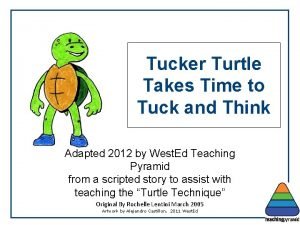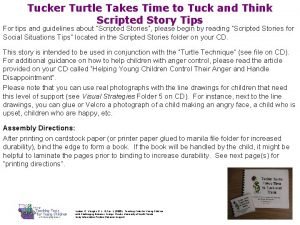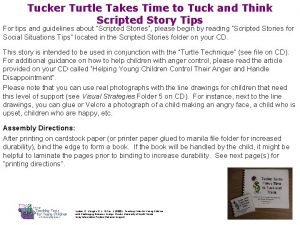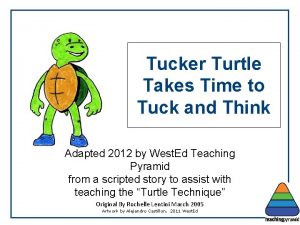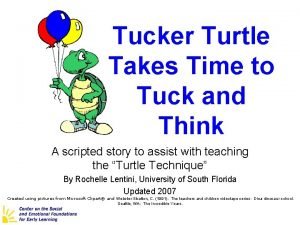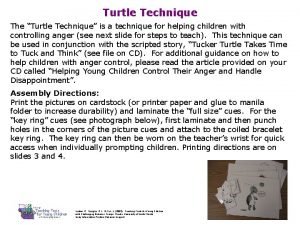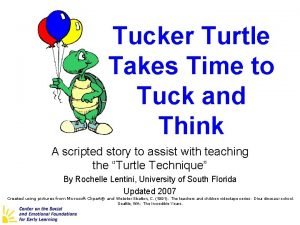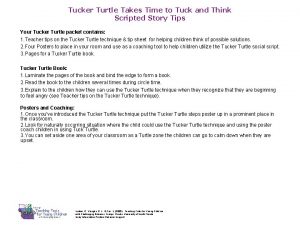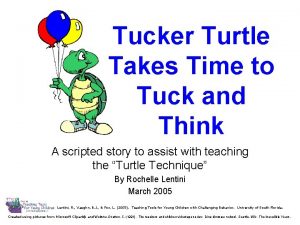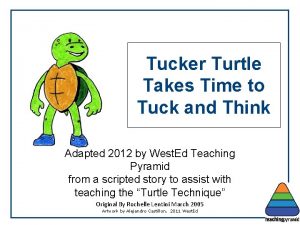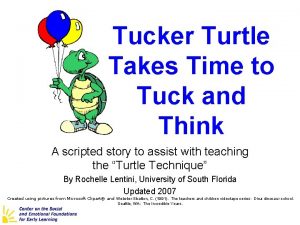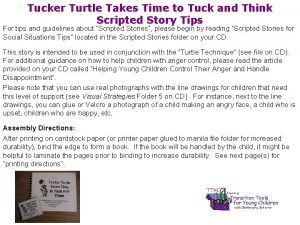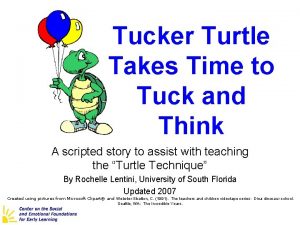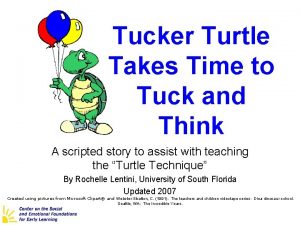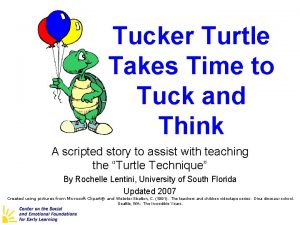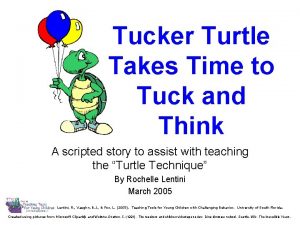Tucker Turtle Takes Time to Tuck and Think

















- Slides: 17

Tucker Turtle Takes Time to Tuck and Think Scripted Story Tips For tips and guidelines about “Scripted Stories”, please begin by reading “Scripted Stories for Social Situations Tips” located in the Scripted Stories folder on your CD. This story is intended to be used in conjunction with the “Turtle Technique” (see file on CD). For additional guidance on how to help children with anger control, please read the article provided on your CD called “Helping Young Children Control Their Anger and Handle Disappointment”. Please note that you can use real photographs with the line drawings for children that need this level of support (see Visual Strategies Folder 5 on CD). For instance, next to the line drawings, you can glue or Velcro a photograph of a child making an angry face, a child who is upset, children who are happy, etc. Assembly Directions: After printing on cardstock paper (or printer paper glued to manila file folder for increased durability), bind the edge to form a book. If the book will be handled by the child, it might be helpful to laminate the pages prior to binding to increase durability. See next page(s) for “printing directions”. Lentini, R. , Vaughn, B. J. , & Fox, L. (2005). Teaching Tools for Young Children with Challenging Behavior. Tampa, Florida: University of South Florida, Early Intervention Positive Behavior Support.

La Tortuga Tucker Toma su tiempo para pensar Una historia de "scripts" para ayudar con la enseñanza de la “Técnica de la Tortuga” Por Rochelle Lentini Marzo 2005 Lentini, R. , Vaughn, B. J. , & Fox, L. (2005). Teaching Tools for Young Children with Challenging Behavior. University of South Florida. Created using pictures from Microsoft Clipart® and Webster-Stratton, C. (1991). The teachers and children videotape series: Dina dinosaur school. Seattle, WA: The Incredible Years.

La Tortuga Tucker es una tortuga fabulosa. Le gusta jugar con sus amigos en La escuela del Lago Mojado.

Pero a veces ocurren cosas que pueden hacer que Tucker realmente se enoje.

Antes cuando Tucker se enojaba, el golpeaba, daba patadas o les gritaba a sus amigos. Sus amigos se enojaban o se molestaban cuando Tucker golpeaba, pateaba o les gritaba.

Ahora Tucker sabe una nueva manera de "pensar como una tortuga" cuando se enoja. Step 1

El se puede detener y mantener sus manos, su cuerpo y sus gritos dentro de sí mismo! Step 2

Él puede meterse dentro de su caparazón y tomar tres respiros profundos para calmarse. 1… 2… 3… Step 3

Tucker puede pensar en una solución o una mejor manera de hacerlo. Step 4

Los amigos de Tucker están felices cuando juega bien y mantiene su cuerpo a sí mismo. A sus amigos también le gusta cuando Tucker utiliza hermosas palabras o cuando tiene una maestra para ayudarlo cuando el está molesto.

Fin!

Teacher Tips on the Turtle Technique • Model remaining calm • Teach the child the steps of how to control feelings and calm down (“think like a turtle”) – Step 1: Recognize your feeling(s) – Step 2: Think “stop” – Step 3: Tuck inside your “shell” and take 3 deep breaths – Step 4: Come out when calm and think of a “solution” • Practice steps frequently (see cue cards on next 4 pages) • Prepare for and help the child handle possible disappointment or change and “to think of a solution” (see list on last page) • Recognize and comment when the child stays calm • Involve families: teach the “Turtle Technique” Webster-Stratton, C. (1991). The teachers and children videotape series: Dina dinosaur school. Seattle, WA: The Incredible Years.

Step 1

Step 2

1… 2… 3… Step 3

Step 4

Ayuda al Niño a pensar en una posible solución: • Ir por la maestra • Pedir educadamente • Ignorar • Jugar • Decir "Por favor, detente". • Decir "Por favor". • Compartir • Intercambiar un juguete/cosa • Esperar y tomar su turno • Etcétera Lentini, R. , Vaughn, B. J. , & Fox, L. (2005). Teaching Tools for Young Children with Challenging Behavior. Tampa, Florida: University of South Florida, Early Intervention Positive Behavior Support.
 Tucker turtle technique
Tucker turtle technique Tucker turtle takes time to tuck and think
Tucker turtle takes time to tuck and think Tucker turtle
Tucker turtle What is the turtle technique
What is the turtle technique Tucker turtle story
Tucker turtle story Tucker turtle takes time to tuck and think
Tucker turtle takes time to tuck and think Emotional competence
Emotional competence Tucker turtle steps
Tucker turtle steps Tucker turtle pdf
Tucker turtle pdf Tucker turtle book
Tucker turtle book Tucker turtle book
Tucker turtle book Sefel pyramid model
Sefel pyramid model Ramaniklal ambani
Ramaniklal ambani It always takes longer than you think
It always takes longer than you think Time speak
Time speak Reach and tuck
Reach and tuck The time and location in which a story takes place
The time and location in which a story takes place A little bird by aileen fisher
A little bird by aileen fisher
